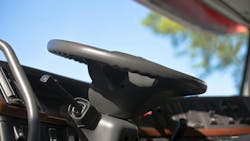California is preparing regulations to allow autonomous heavy-duty trucks across the state, which could open up true coast-to-coast robotic freight movement.
The California Department of Motor Vehicles published proposed regulations that would permit autonomous commercial motor vehicles with a GVWR of 10,001 or greater on public roads. Driverless truck operation testing is underway across many Sunbelt States. Still, California has limited operations within its borders, which has limited AV companies' plans to create autonomous freight networks that connect the Atlantic and Pacific Coasts.
The state DMV published its draft regulatory language to solicit public feedback before the autonomous vehicle regulation takes shape.
“California continues to lead the nation in transportation innovation as we embrace new technologies,” Steve Gordon, director of the California DMV, said in an announcement of the draft regulations. “The meticulous, phased-in approach we are taking in this rulemaking process is designed to yield the safest and most comprehensive regulations for autonomous vehicles.”
The draft regulations come in three separate documents:
- A summary and request for feedback
- A description of AV testing procedures
- A description of AV deployment procedures
See also: The current state of autonomous trucking
What the draft regulations say
California currently prohibits autonomous vehicles with a gross vehicle weight rating of 10,001 or greater. The draft outlines a regulatory path for the testing and permitting of autonomous commercial vehicles on public roads.
The draft regulations only allow certain heavy-duty vehicles. The state would still prohibit autonomous vehicles from moving household goods, passenger vehicles, hazardous materials, and bulk liquids in tankers.
Deployment and testing would be limited to two types of public roads: roads with a speed limit greater than 50 miles per hour and frontage access roads.
The driverless autonomous vehicles would still need remote assistants or operators ready to take control of the vehicle within a few moments of an unexpected event. These remote assistants/operators would need to comply with federal commercial driver requirements, including licensing and hours-of-service restrictions.
The testing and permit process
The draft regulations outline a multi-phase testing and permitting process for AV manufacturers. At the end of the process, a fully permitted vehicle could deploy on public streets for commercial operation.
The process would be separate for light-duty and heavy-duty operations, though similar in structure. For each autonomous commercial motor vehicle, manufacturers would have to acquire a separate permit. The types of permits are:
- A drivered testing permit;
- A drivered deployment permit;
- A driverless testing permit; and
- A driverless deployment permit.
A manufacturer would need to pass drivered testing to receive a drivered deployment permit or a driverless testing permit. They would need to pass driverless testing to receive a driverless deployment permit.
The fee to acquire each respective permit is still undetermined. In a previous version of the draft regulations, however, manufacturers would have paid $3,600 to process a permit.
For either testing permit, a manufacturer would have to provide a “safety case,” which, according to the draft regulations, is a “structured argument, supported by a body of relevant evidence, that provides a compelling, comprehensible, and valid case that an automated driving system, for a given operational design domain, does not pose an unreasonable risk to the safety of vehicle occupants, other road users, and the public.” The state DMV would require this case to address organizational safety, the vehicle’s safety, and operational safety.
To acquire a driverless testing permit or deployment permit, the manufacturer must successfully test a vehicle for a set number of months and miles. The exact length of time and number of miles, however, is still undetermined.
The manufacturer would also have to provide an assessment of the drivered testing results. The assessment would prove that the automated driving system could operate safely under its designated environment. The manufacturer would also need to provide a law enforcement interaction plan, detailing how first responders and law enforcement can safely interact with a driverless vehicle or its operator.
The vehicle would also have to meet SAE’s J3016 definition for a level 4 or level 5 automated driving system.
In its draft, the California DMV plans to have free control to restrict a manufacturer’s permits by fleet size, hours of operation, or geographic area of operation.
With drivered testing, a test driver would remain in the vehicle to take control of the vehicle when necessary. The test driver would still have to abide by federal commercial driver requirements, including licensing and hours-of-service restrictions.
With driverless testing, the vehicle would be monitored by a remote driver or remote assistant to take control of the vehicle when necessary. These remote drivers/assistants would also have to abide by federal commercial driver requirements.
Under the draft regulation, there would be two types of deployment permits: one that requires a driver located in the driver’s seat of the vehicle and one that does not require a driver. The former would only need to pass drivered testing, while the latter would need to pass both drivered and driverless testing.
See also: Daimler sets out to demonstrate how autonomous EVs could change trucking
How to submit feedback
The California DMV is requesting input on its draft regulatory language, including the undetermined numbers in its testing/permitting processes.
Input can be emailed to [email protected] no later than October 14. The DMV requires the input to include the name of a person or organization for consideration.
Some of the fields the state DMV wants input for include:
- What might be the appropriate criteria for establishing long-haul operational design domains?
- What might be the appropriate thresholds for the amount of testing (both time and mileage) that must be completed by a light-duty and heavy-duty autonomous vehicle manufacturer in order to progress to the next permitting phase?
The state DMV did not share a timeline for when this proposed language might become final. With a feedback deadline of October 14, the official regulatory process will likely not begin to take shape until late 2025.
Legislative conflict
Autonomous vehicles are a contentious topic in California’s legislative environment. A majority of the state legislature aims to tighten regulations over autonomous vehicles, while Governor Gavin Newsom historically opposed these efforts.
In September 2023, Newsom vetoed a bill that would have required human operators in autonomous vehicles with a GVWR of more than 10,000 lb. until 2030. The bill, Assembly Bill 316, also included public reporting requirements for AV operations.
In his veto message, Newsom said the regulation was "unnecessary" because existing law already allows sufficient authority to develop a regulatory framework, and that the draft regulations would likely be released for public comment "in the coming months."
The state legislature did not try to override Newsom’s veto, despite the bill passing with an overwhelming majority in both the Senate and Assembly. The legislature has not pursued a gubernatorial veto in over 40 years.
During the same week as the state DMV’s draft regulatory language, the California legislature voted to pass two new bills for autonomous vehicles.
The first, AB 3061 would require AV manufacturers to publicly report AV operational statistics, including collisions, traffic violations, and more. The second, AB 2286, is almost identical to 2023’s AB 316—requiring, in addition to operational reporting, a human operator present in heavy-duty AVs during operation until at least 2030.
Both bills now go to Newsom to sign or veto.
See also: CVSA and Kodiak remove autonomous trucking’s inspection hurdle
Industry response
Jeff Farrah, CEO of the Autonomous Vehicle Industry Association, applauded the draft regulation.
"AVIA applauds Governor Gavin Newsom and the California DMV on the release of the proposed regulations and looks forward to reviewing and engaging constructively,” Farrah said. “The AV industry has stressed the importance of releasing these regulations for several years. This announcement further underscores why AB 2286 and AB 3061 are unnecessary and should be vetoed by Governor Newsom.”
The International Brotherhood of Teamsters, a major labor union historically opposed to AVs, condemned the draft regulation. Sean O’Brien, Teamsters general president, said the draft regulation documents “threaten good jobs and public safety.” The union instead supports AB 2286 and AB 3061.
About the Author
Jeremy Wolfe
Editor
Editor Jeremy Wolfe joined the FleetOwner team in February 2024. He graduated from the University of Wisconsin-Stevens Point with majors in English and Philosophy. He previously served as Editor for Endeavor Business Media's Water Group publications.

